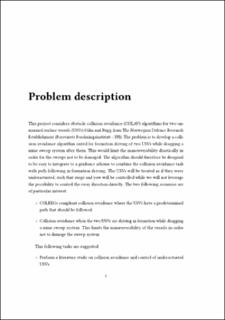| dc.contributor.advisor | Pettersen, Kristin Ytterstad | |
| dc.contributor.advisor | Ruud, Else-Line Malene | |
| dc.contributor.advisor | Bitar, Glenn Ivan | |
| dc.contributor.author | Hansen, Harald Minde | |
| dc.date.accessioned | 2023-09-20T17:21:41Z | |
| dc.date.available | 2023-09-20T17:21:41Z | |
| dc.date.issued | 2023 | |
| dc.identifier | no.ntnu:inspera:140443607:37549646 | |
| dc.identifier.uri | https://hdl.handle.net/11250/3090940 | |
| dc.description.abstract | Denne oppgaven omhandler kollisjonsunngåelse med hindringer for de to ubemannede underaktuerte overflatefartøyene (USV) Frigg og Odin. USV-ene drar et minesveipsystem etter seg, som begrenser USV-ene til å kjøre i en ønsket formasjon med manøvreringsbegrensninger. Metoden kalt konstant unngåelsesvinkel (CAA) er valgt og utvidet til å følge COLREGs, bruke en hysterese basert på nærmeste tilnærmingspunkt (CPA) og å konvertere sikkerhetsmargin fra heading-rom til absolutte distanser. Kollisjonsunngåelsesoppgaven er integrert i nullromsbasert (NSB) oppførselsstyring ved å legge det inn i en barysenter banefølgingsoppgave. Denne oppgaven har lavest prioritet etter oppgavene om kollisjonsunngåelse mellom fartøyene og formasjonskjøring. Kollisjonsunngåelsesalgoritmen er kalkulert fra barysenter av de to USV-ene, og en ny bane er generert for å få barysenter til å følge konstant unngåelsesvinkel når kollisjonsunngåelse er aktivert. Innskrevne sirkler med konstant radius i banegenereringen er foreslått for å ta høyde for manøvreringsbegrensninger, og for å sikre at USV-ene følger referansebanen. Dette sikrer også en glatt bane og en kontinuerlig heading-referanse. En matematisk analyse er gjort for én USV for å garantere kollisjonsunngåelse med én hindring. Et simulasjonsstudie med alle de valgte COLREGs-scenariene er gjennomført i tillegg til eksperimenter fra det virkelige systemet med USV-er for å validere metoden. | |
| dc.description.abstract | This thesis considers obstacle collision avoidance for the two unmanned underactuated surface vessels (USVs) Frigg and Odin. The USVs are dragging a mine sweep system after themselves, which restricts the USVs to drive in a desired formation with maneuvering limitations. The constant avoidance angle method is chosen and extended with COLREGs compliance, closest point of approach based hysteresis and conversion of safety margins from heading space to absolute distances. The collision avoidance task is integrated into the null-space-based (NSB) behavioral control scheme by embedding it into a barycenter path following task. This task has the lowest priority after inter-vessel collision avoidance and formation tasks. The collision avoidance algorithm is calculated from the barycenter of the two USVs, and a new trajectory is generated to make the barycenter follow the constant avoidance angle when the collision avoidance mode is active. To account for maneuvering limitations, a fixed- radius inscribed circles approach is proposed in the trajectory generation to ensure that the USVs are able to track the reference path. This also ensures a smooth path and a continuous heading reference. A mathematical analysis is performed for one USV to guarantee collision avoidance with one obstacle. A simulation study with all the selected COLREGs scenarios is performed together with real-world experiments with the USVs to validate the method. | |
| dc.language | eng | |
| dc.publisher | NTNU | |
| dc.title | Collision Avoidance for Two Autonomous USVs in Formation With Maneuvering Limitations | |
| dc.type | Master thesis | |
